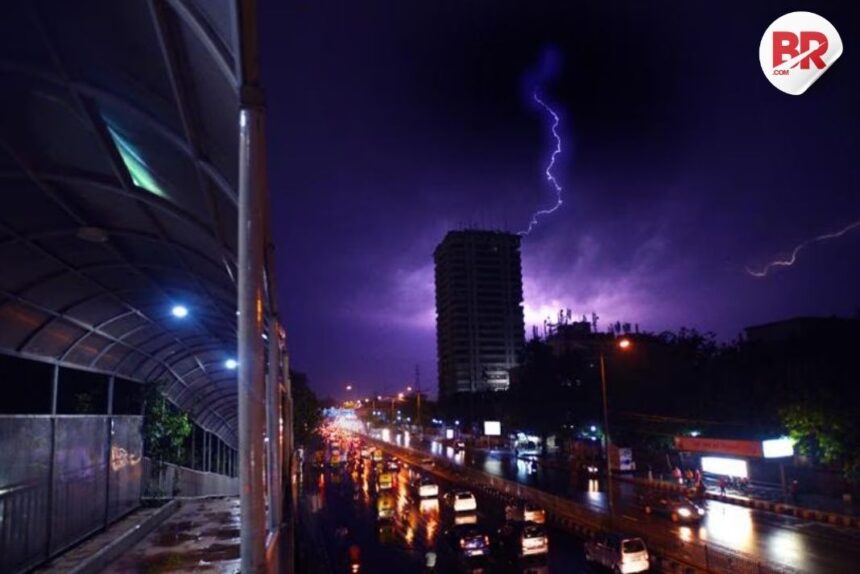
Delhi Storm: What Happened and Why It’s a Wake-Up Call
In an unexpected twist, Delhi was hit by a storm of monumental intensity, leaving the city grappling with fallen trees, power outages, and severe disruption. This wasn’t just a typical monsoon mishap – it was a rare weather event that experts say could become more common in the future. Here’s how it unfolded.
The Culprit: Dual Moisture Inflow
So, what made this Delhi storm so extreme? The answer lies in a rare combination of moisture from two different sources: the Arabian Sea and the Bay of Bengal. Normally, weather patterns in North India are influenced by one of these at a time. But when both of these moisture-laden winds converged over Delhi, things got chaotic.

- Arabian Sea Moisture: Brings in moist winds from the west, usually influencing the monsoon season.
- Bay of Bengal Moisture: Moves in from the east, significantly affecting weather systems in the eastern and northeastern parts of India.
When these two forces collided over the capital, it set the stage for a storm unlike anything we’ve seen in a while.
The national capital woke up to this after thunderstorm and rain. Trees uprooted. Vehicles damaged. This is Sheikh Sarai Phase-2. #DelhiRains #Delhi pic.twitter.com/pRWepLAnrM
— Bhavya Khanna (@bhavyakhannaaa) May 2, 2025
Why This Matters to You
For the average Delhiite, this storm wasn’t just another downpour. It’s a warning. While rare, this kind of storm is a product of the changing climate, and it could very well become a more frequent occurrence. Think about it: two moisture sources. A perfect mix. But not exactly a cocktail you’d want to sip on.
Add to this the Western Disturbance, a Mediterranean-origin weather system, sweeping across the region, and the intense heat from the days before, and you have all the ingredients for the storm that hit.
What Else Triggered the Storm?
Beyond the moisture duel, other factors played a role:
- Western Disturbance: This brought in clouds and precipitation, already primed for storm action.
- Temperature Differences: The difference in temperature between the ground and the atmosphere created an unstable environment ripe for thunderstorm formation.
- Convective Activity: After a heatwave, the rising warm air already made conditions ripe for the storm to form.
All of these factors collided, forming what meteorologists refer to as a “perfect storm.”
Impact: A City Left Reeling
Once the storm hit, the consequences were felt far and wide. Roads were blocked by fallen trees, traffic came to a standstill, and power lines were downed across the city. The damage to infrastructure was severe, with buildings and vehicles suffering from the strong winds and relentless rain.
On the flip side, the storm temporarily cleared up Delhi’s notorious air pollution – a silver lining in an otherwise dark cloud. Ironically, the very thing that caused so much destruction also gave the city a brief respite from toxic air.
🚨Delhi-NCR Weather Alert!
Storms,heavy rain & chaos all around-Gurugram is flooded,flights delayed,and sadly,some lives lost.
IMD warns:storms coming this week!
Quick safety tips:
Avoid waterlogged roads
Stay away from electric poles
Check flights before you leave#DelhiWeather pic.twitter.com/5nKfjWI8A4— Probus (@ProbusInsurance) May 2, 2025
What Does the Future Hold?
While it’s impossible to predict every storm, one thing is certain: climate change will likely increase the frequency of such extreme weather events. What does that mean for us? It means more storms like the one we saw in Delhi. But with preparation, we can mitigate some of the damage.
- Strengthening Infrastructure: Our buildings and power grids need to be ready for more intense storms.
- Better Weather Forecasting: With the right tech, we can get timely warnings and be more prepared.
- Public Awareness: Educating people on how to respond to these events could save lives and property.
This storm isn’t just a freak event; it’s a reminder of the power nature holds – and how crucial it is for us to stay prepared.
The Takeaway: Nature Knows No Mercy
The recent Delhi storm was a testament to nature’s force. But, more importantly, it shows us how little we understand about weather systems, especially when they converge in unexpected ways. We can only hope this serves as a wake-up call. If not, the next storm might not be so forgiving.
Also Read Delhi Storm Strikes: The Heartbreaking Loss of a Mother and Her Children












